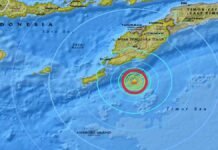
Key Points:
- A 7.7-magnitude earthquake struck Myanmar on March 28, killing over 2,000 people and injuring 3,400.
- The quake unleashed energy equivalent to 334 atomic bombs and caused widespread destruction in Myanmar and neighboring regions.
- Myanmar’s ongoing civil war and communication blackout are hindering relief efforts.
- India launched “Operation Brahma,” sending 15 tonnes of aid and rescue teams to assist Myanmar.
- Tremors were felt in Thailand and China, with a building collapse in Bangkok killing 17 and leaving dozens trapped.
New Delhi: A devastating 7.7-magnitude earthquake struck central Myanmar on Friday, March 28, leaving over 2,000 dead and thousands injured in one of the most powerful quakes the region has experienced in over a century. The epicenter was located near Mandalay at a shallow depth of 10 kilometers, intensifying the destruction across cities and rural areas alike. Neighboring Thailand and parts of China also felt the tremors, with significant casualties reported in Bangkok.
Unprecedented Destruction in Myanmar
The earthquake, described by geologist Jess Phoenix as releasing energy equivalent to “334 atomic bombs,” has left cities in ruins and rural communities devastated. Mandalay, Myanmar’s second-largest city, suffered extensive damage, with buildings collapsing and roads buckling under the force of the quake. The Sagaing region, known for its less sturdy wooden homes, also faced widespread destruction.
According to the United States Geological Survey (USGS), the earthquake was followed by over 70 aftershocks, including a powerful 6.7-magnitude tremor just minutes later. Experts warn that aftershocks could persist for months due to ongoing tectonic activity between the Indian and Eurasian plates.
Myanmar’s military junta reported over 2,000 fatalities as of Saturday evening, but USGS estimates suggest the death toll could exceed 10,000 as rescue efforts continue. Hospitals are overwhelmed with injured victims, while many remain trapped under rubble due to a lack of heavy machinery for rescue operations.
Civil War Complicates Relief Efforts
Myanmar’s ongoing civil war has severely impeded disaster response efforts. Communication blackouts and infrastructure damage have left many areas inaccessible to aid workers. The National Unity Government (NUG), an opposition group fighting against the military junta, announced a temporary ceasefire in quake-hit regions to facilitate relief operations.
Local residents described harrowing scenes of destruction. A woman from Mandalay told CNN how her grandmother was trapped under rubble when part of their house collapsed. “We cried for help as we struggled to free her,” she said.
In Sagaing, residents reported minimal government assistance. “We have no power or drinking water,” said Han Zin, a local resident. “The town is completely destroyed.” Community groups are leading makeshift rescue efforts with limited resources.
Impact Beyond Myanmar: Thailand and China
The earthquake’s effects were felt across Southeast Asia. In Bangkok, Thailand’s capital, a partially constructed 30-story building collapsed during the tremors, killing 17 people and injuring dozens more. Rescue teams are working to free over 40 workers still trapped under the rubble.
China’s Yunnan province also experienced strong tremors but reported no major casualties. However, structural assessments are underway to evaluate damage in affected areas.
India’s Swift Response: Operation Brahma
India has emerged as a key responder to the crisis through “Operation Brahma.” On Saturday, an Indian Air Force aircraft delivered 15 tonnes of relief supplies to Yangon, including tents, blankets, sleeping bags, food packets, water purifiers, solar lamps, generators, and essential medicines.
India also deployed an 80-member National Disaster Response Force (NDRF) team equipped with rescue dogs and advanced tools like concrete cutters. A field hospital staffed by medical professionals has been set up in Mandalay to treat survivors.
“India stands in solidarity with Myanmar during this difficult time,” Prime Minister Narendra Modi said after speaking with Myanmar’s junta leader Min Aung Hlaing.
Global Aid Efforts Intensify
International aid is pouring into Myanmar despite logistical challenges posed by its civil war. Countries like China, Russia, Singapore, Malaysia, and South Korea have sent rescue teams and humanitarian supplies. Singapore dispatched a team of rescuers accompanied by trained dogs to Mandalay.
The United Nations has warned that economic losses from the disaster could exceed Myanmar’s annual GDP due to extensive damage to infrastructure such as airports, highways, and bridges.
A Nation in Crisis
Myanmar is grappling with its worst natural disaster since Cyclone Nargis in 2008 amid an already dire humanitarian situation caused by years of conflict. The earthquake has further exposed vulnerabilities in disaster preparedness and governance under military rule.
As rescue operations continue against overwhelming odds, the international community faces mounting pressure to provide sustained support for recovery efforts in this war-torn nation.



















































